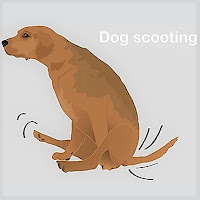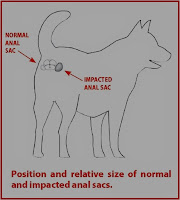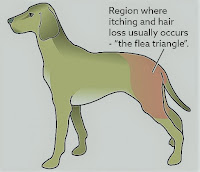What's Scooting In Dogs
What is Scooting?
Even though scooting isn't usually an emergency, it's never a standard dog behavior so it's important to seek out out why your pet is doing it. Check under your dog’s tail for signs of redness, swelling, fecal matter, blood, or the other abnormal problems. If there's no sign of irritation, the matter could also be itching or constipation and you ought to call your veterinarian to form a meeting.
If your dog is scooting his butt on the ground, this is often a symbol that something is wrong. He could also be itching, in pain, or he could also be constipated. you'll think it's just a behavioral issue, but your dog is trying to inform you something. Actually, there are many reasons why your dog would be scooting like worms, anal gland disorders, injury, tumors, and far more. it's important that you simply determine the rationale why your dog is scooting because a number of the conditions are often serious and he's obviously uncomfortable.
Symptoms of Scooting in Dogs:
The signs of scooting in dogs are (of course) scooting, but there also are signs that your dog has been scooting albeit you've got not witnessed it yet.
- Biting or licking the affected area.
- Matted fur in the anal area.
- Foul odor from the affected area.
- Worms or white specks in the anal area.
- Scooting buttocks on the ground, carpet, or ground.
Causes of Scooting in Dogs:
There are many possible causes of scooting but the foremost common include:
- Anal sac impaction.
- Diarrhea or constipation.
- Tumor.
- Worms.
Treatment of Scooting in Dogs:
The treatment for scooting depends on the cause. Anal gland expression, medication, and even surgery could also be needed for a few conditions like tumors.
Anal Gland Expression
to precise the anal glands, the veterinarian will just apply pressure to each side of the anal opening on the surface of every anal gland. Pushing in and upward should cause the fabric to return out of the sacs.
Medication
If there's an infection, the vet will give your dog an antibiotic injection and should send you home with a prescription for pain medicine. A diet with more fiber will likely be recommended to stop a recurrence. Medication for worms depends on which sort of worm your dog has.
Surgery
The veterinarian may do the surgery to get rid of the tumor otherwise you could also be sent to a veterinarian or pathologist. it's a secure surgery with few risks. If the tumor is malignant (cancerous), your dog may have radiation or chemotherapy also.
Recovery of Scooting in Dogs:
Your dog’s prognosis is sweet, but the scooting may return if the matter returns. Anal gland impaction can become chronic and your veterinarian may recommend the removal of the glands to prevent the matter. If your dog has worms, make certain to follow the instructions for the medication and check for worms within the fecal matter for several weeks. If you've got questions, call your veterinarian.
Dog Allergies
Have you heard someone tell you that her dog has allergies? Has your veterinarian suggested that allergies might be a drag for your dog? does one suspect that your dog has allergies?
If so, then you’ve probably realized that allergies in dogs aren't quite as simple as we'd wish. For starters, there are several different types of allergies that would be causing your dog’s symptoms.
Types of Allergies in Dogs:
Allergies are a misguided reaction to foreign substances by the body’s system, which, of course, people and pets can suffer from. There are quite a few differing types of allergies in dogs. Skin allergies, food allergies, and environmental allergens all pose challenges for dogs and their owners, and to form things more complicated, the symptoms of these different types of allergies can overlap.
Skin Allergies
Skin allergies, called allergic dermatitis, are the foremost common sort of allergies in dogs. There are three main causes of skin allergies in dogs:
- Flea allergy dermatitis.
- Food allergies.
- Environmental allergens.
Flea allergy dermatitis is an allergy to fleabites. Some dogs are allergic to flea saliva. This makes affected dogs extremely itchy, especially at the bottom of the tail, and their skin may become red, inflamed, and scabbed. you'll also notice signs of fleas, like flea dirt, or maybe see the fleas themselves.
Food allergies and sensitivities can cause itchy skin, as well. the foremost common places dogs with food allergies itch are their ears and their paws, and this might be amid gastrointestinal symptoms.
Environmental allergens, like dust, pollen, and mold, can cause atopic allergies or atopic eczema. In most cases, these allergies are seasonal, so you'll only notice your dog itching during certain times of the year. like food allergies, the foremost commonly affected areas are the paws and ears (but also include the wrists, ankles, muzzle, underarms, groin, around the eyes, and in between the toes).
All skin allergies pose the danger of secondary infection. As your dog scratches, bites, and licks at his skin, he risks opening up his skin to yeast and bacterial infections which will require treatment.
Food Allergies And Diarrhea
True food allergies might not be as common as people think, consistent with AKC Chief Veterinary Officer Dr. Jerry Klein. True food allergies end in an immune reaction, which may home in symptoms from skin conditions ( hives, facial swelling, itchiness), gastrointestinal signs (vomiting and/or diarrhea) or a mixture of both. In some rare cases, a severe reaction leading to anaphylaxis can occur — almost like severe peanut allergies in humans
But what about all of these dogs that are on special hypoallergenic diets?
What most people mean once they say that their dog features an allergy is that their dog features a food sensitivity, also referred to as food intolerance. Food sensitivities, unlike true allergies, don't involve an immune reaction and are instead a gradual reaction to an offending ingredient in your dog’s food, as an example to beef, chicken, eggs, corn, wheat, soy, or milk.
Dogs with food sensitivities can present with several symptoms, including gastrointestinal signs like vomiting and diarrhea, or dermatologic signs like itchiness, poor skin and coat, and chronic ear or foot infections.
The best solution to diagnosing and treating an allergy is to figure together with your veterinarian to manage your dog’s symptoms and find out the ingredient causing the reaction.
Reactions Of Intense Allergies
Perhaps the foremost alarming of all the kinds of allergies in dogs is an acute allergy. Dogs, like people, can enter anaphylaxis if they need a severe reaction to an allergen. this will be fatal if not treated.
Bee stings and vaccine reactions, among other things, can cause an anaphylactic response in some dogs, which is why it's always an honest idea to stay an in-depth eye on your dog following the administration of any new vaccine, drug, or food item. Luckily, anaphylactic reactions are rare in dogs.
Your dog can also develop hives or facial swelling in response to an allergen. Swelling of the face, throat, lips, eyelids, or earflaps may look serious but is never fatal, and your veterinarian can treat it with an antihistamine.
Symptoms of Allergies in Dogs:
The symptoms of allergies in dogs may vary counting on the cause. A dog that goes into anaphylaxis, for instance, will have a drop by blood glucose followed by shock, which is extremely different from a skin condition.
In general, however, the subsequent symptoms might be a symbol of an allergy:
- Itchiness.
- Hives.
- Swelling of the face, ears, lips, eyelids, or earflaps.
- Red, inflamed skin.
- Diarrhea.
- Vomiting.
- Sneezing.
- Itchy ears.
- Chronic ear infections.
- Itchy, runny eyes.
- Constant licking.
Some of these symptoms could even be a symbol of another condition. Make a meeting together with your veterinarian to urge an accurate diagnosis and to assist your dog start feeling better.
Diagnosing Allergies in Dogs:
If you've got ever undergone allergy testing, then you recognize that diagnosing allergies is usually complicated.
The first thing your veterinarian may prefer to do is rule out the other condition that would be causing your dog’s symptoms. If your veterinarian feels that an allergy may be a likely cause, he or she may propose allergy testing to undertake and determine the explanation for the allergen that's causing the reaction. However, confine mind it's going to not always be possible to work out the explanation for an allergy with testing.
Food allergies are often diagnosed using an elimination diet. A food trial consists of feeding a dog a completely unique (i.e. one) source of protein and carbohydrate for 12 weeks.
Flea allergy dermatitis is usually the simplest allergy to diagnose. it's usually diagnosed by identifying fleas on your dog’s body and applying a product that kills fleas before they will bite to ascertain if that solves the problems.
Treating Allergies in Dogs:
The best way to treating an allergy is the avoidance of the cause and allergen. this might or might not always be possible. But, in terms of treatment, it depends on your dog’s sort of allergy. for instance, the simplest way to treating flea allergy dermatitis are to kill fleas, whereas the simplest thanks to treating an allergy or food intolerance may be a change in diet.
In addition to any lifestyle changes which may be necessary, your veterinarian can also prescribe a medicine for your dog which will help control the signs related to the allergy, like itching and any secondary skin infections which may have developed as a result of the irritant.
If your dog features a severe allergy, your best course of action is to urge him to an emergency veterinary hospital as quickly as possible.



















0 comments:
Post a Comment